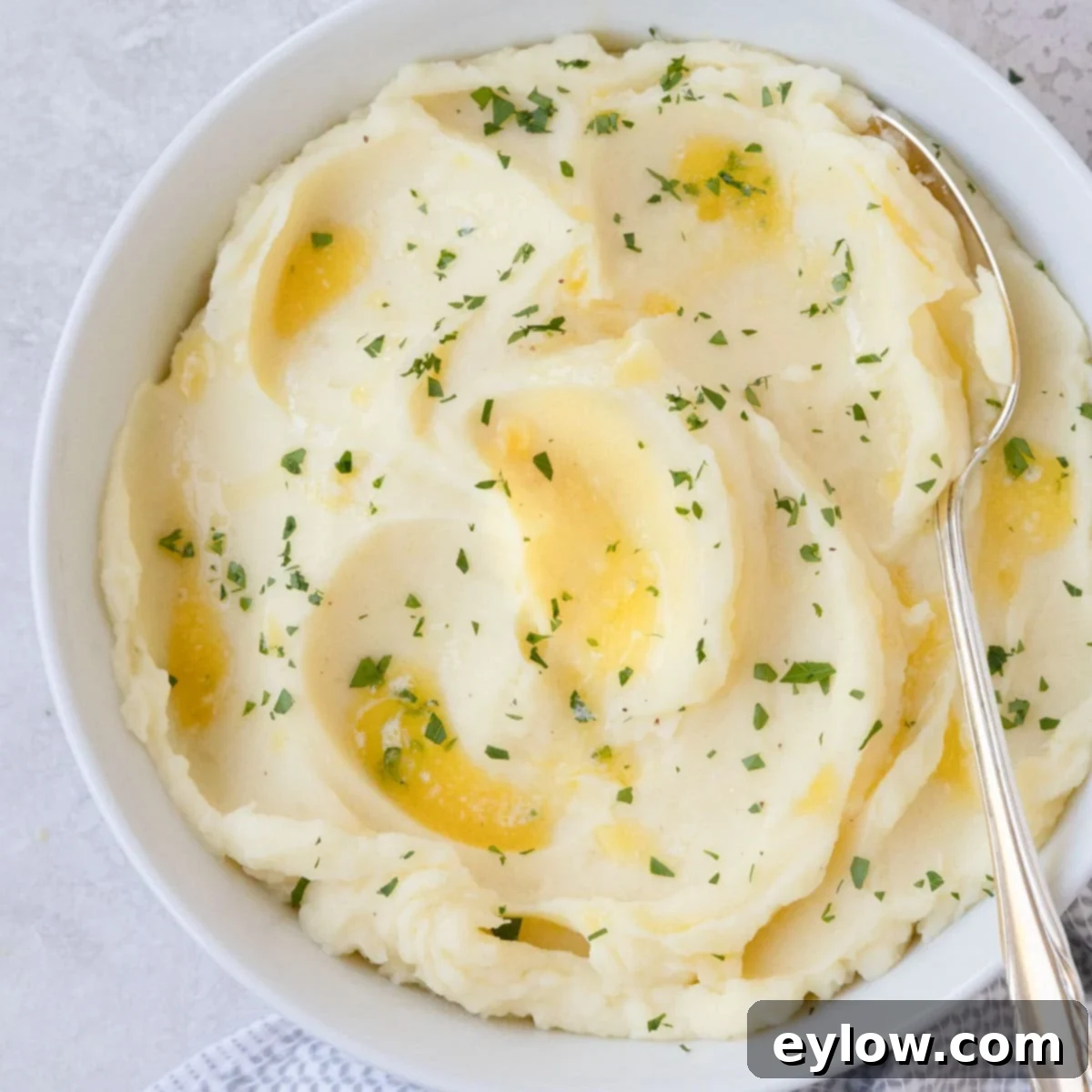The Ultimate Guide to Fluffy Riced Mashed Potatoes: Your Secret to Perfection
Ever wondered how to achieve the dreamiest, most impossibly fluffy mashed potatoes that practically melt in your mouth? The secret lies in one often-overlooked kitchen tool: the potato ricer. Ditch your old hand masher, put away the electric mixer (which can lead to gummy results), and embrace the ricer for truly riced mashed potatoes. This simple technique is a complete game-changer, transforming ordinary potatoes into an extraordinary side dish that will have everyone clamoring for seconds. Whether you’re preparing a festive holiday feast or a comforting weeknight meal, homemade mashed potatoes are a timeless classic, and with a ricer, they reach new heights of culinary excellence. Let’s dive into the easy, step-by-step process to create these swoon-worthy spuds.

Over the years, while hosting friends for dinner, I’ve noticed a common curiosity: guests inevitably gravitate towards the kitchen, observing my cooking methods. More often than not, when I pull out my potato ricer for mashed potatoes, I’m met with puzzled looks. Many have never seen or used this ingenious device. That’s why I felt it was essential to share my comprehensive riced mashed potatoes recipe and elaborate on why this simple, effective, and surprisingly inexpensive kitchen tool is the absolute key to making the best mashed potatoes you’ll ever taste. It’s not just about mashing; it’s about transforming the potato structure to achieve unparalleled fluffiness and creaminess.
[feast_advanced_jump_to]
Why You’ll Love This Recipe for Fluffy Mashed Potatoes
- Using a potato ricer is the ultimate secret to achieving the lightest, most ethereal riced mashed potatoes. It gently processes the cooked potatoes, breaking them down without overworking the starch.
- You’ll get significantly better results than with a traditional hand potato masher, which often leaves lumps, or an electric mixer/food processor, which can over-process the starch and result in an unappetizingly gluey texture. The ricer ensures a consistently smooth and fluffy consistency.
- This recipe is incredibly versatile, offering delicious non-dairy and vegan options so everyone can enjoy these decadent mashed potatoes, regardless of dietary preferences.
- Convenience is key! You can easily make these creamy mashed potatoes ahead of time and keep them warm, or reheat them later with our four tried-and-true methods, ensuring they taste just as good as freshly made. This makes them perfect for busy holidays or meal prepping.
Essential Ingredients for Perfect Riced Mashed Potatoes
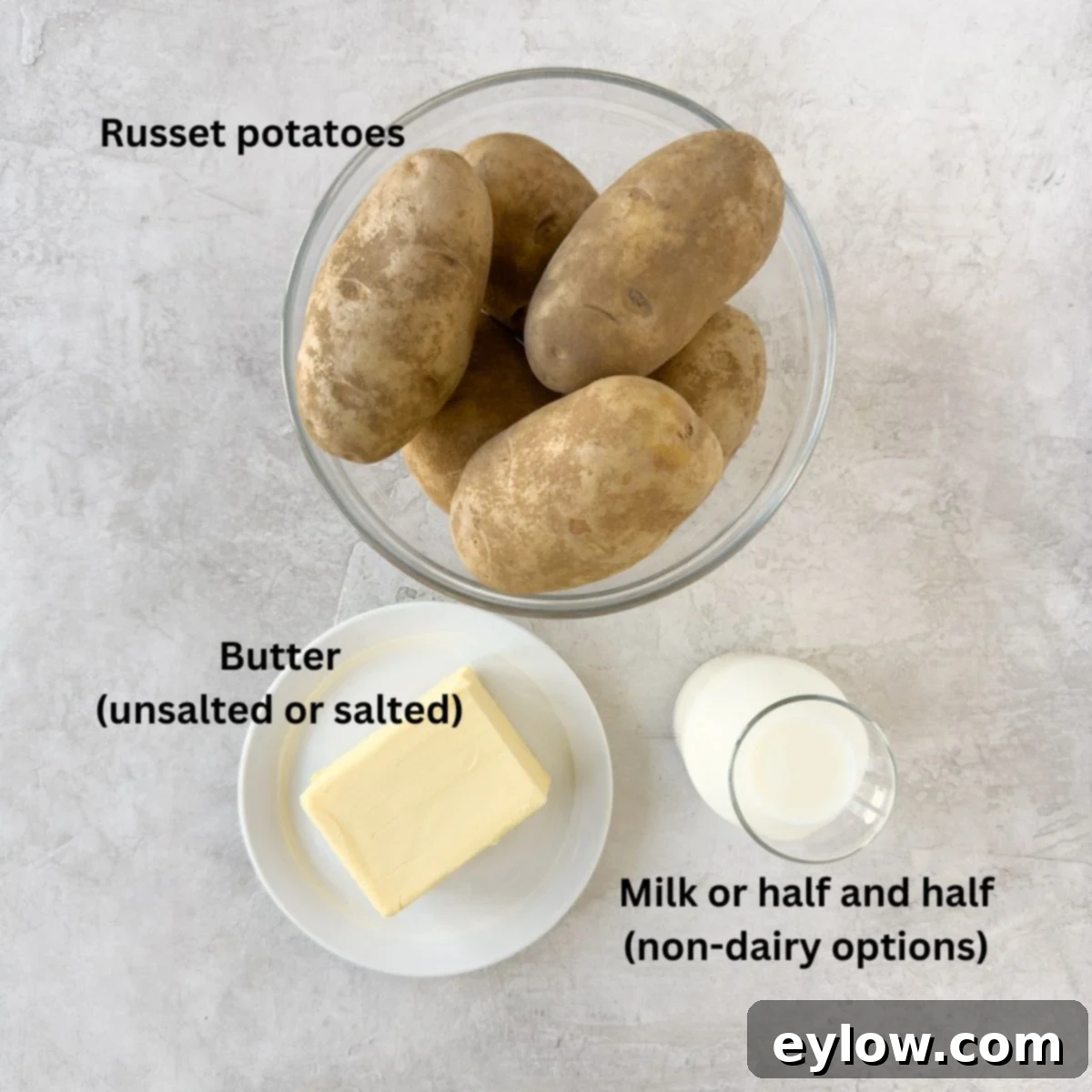
- Potatoes: For truly fluffy, light, and airy mashed potatoes, russet potatoes are your top choice. Their high starch content breaks down beautifully when cooked, resulting in that desired fluffy texture. Avoid waxy varieties like red or gold potatoes if maximum fluffiness is your goal (though Yukon Golds can work for a denser, creamier mash). A good rule of thumb is to calculate about a half pound of potatoes per person for a generous serving.
- Milk: The type of milk you choose impacts the richness and consistency. Low-fat milk offers a lighter texture, while whole milk or half-and-half will yield a creamier, more decadent result. While heavy cream can be used, I find it sometimes makes the potatoes overly rich and heavy, but this is entirely a matter of personal preference. Always warm your milk before adding it to prevent cooling down your hot potatoes.
- Butter: Opt for unsalted butter. This allows you complete control over the overall salt level of your mashed potatoes. If you only have salted butter on hand, remember to significantly reduce or entirely omit any additional salt until you’ve tasted the finished product. Room temperature or slightly melted butter will incorporate more smoothly.
- Fresh Herbs: (Optional, but highly recommended) A sprinkle of fresh chopped chives or parsley adds a vibrant pop of color and a lovely fresh flavor, making for an appealing and easy garnish that elevates the dish.
For precise measurements of these and other seasonings like salt and black pepper (or white pepper, if you prefer to avoid visible black specks for aesthetic reasons), please refer to the detailed recipe card below. To infuse an extra layer of buttery flavor into your riced mashed potatoes, consider folding in a few slices of a savory herbed compound butter – it’s a wonderful touch for special occasions.
Choosing the Best Potatoes for Unbeatable Mashed Potatoes
The foundation of exceptional mashed potatoes begins with selecting the right type of potato. My unequivocal answer for the fluffiest, most delightful mashed potatoes is the russet. However, understanding the characteristics of various potato types will empower you to choose based on your desired texture. Here’s a detailed breakdown of common potato varieties and their suitability for mashing, drawing insights from resources like Potato Goodness:
- Russets: Also known as baking potatoes, russets boast a high starch content and a floury, dry texture. This makes them absolutely ideal for ricing and mashing. When cooked, their cells separate easily, resulting in a wonderfully light, airy, and fluffy consistency. They readily absorb butter and milk, creating that cloud-like mashed potato experience. Russets are the gold standard for riced mashed potatoes.
- Yellow and Gold Potatoes: Varieties like Yukon Golds fall into this category. They have a medium starch content and a naturally buttery flavor and color. While they were once my preferred choice for mashed potatoes, I’ve returned to russets for ultimate fluffiness. Gold potatoes produce a mash that is more velvety, moist, and dense. Their creamier texture is fantastic for certain applications, and I highly recommend trying them mashed sometime to truly appreciate the difference. They excel in dishes where you want a richer, slightly heavier texture, making them my top choice for terrific potato salad and rich potato gratins.
- White Potatoes: These are medium-starch potatoes, offering a balance between creamy and dense. They typically have thin, delicate skin and white interiors. While they can be used for mashed potatoes, they won’t achieve the same level of fluffiness as russets. Their ability to hold their shape after cooking also makes them suitable for roasting or boiling where integrity is desired.
- Red Potatoes: This variety is characterized by its waxy texture, thin red skin, and creamy, moist flesh. Red potatoes have a low starch content, meaning their cells remain intact even after cooking, leading to a denser, smoother, and somewhat stickier mash. For this reason, they are best saved for baking, roasting, or in dishes where they need to hold their shape, such as air fryer red potatoes, classic potato salads, and hearty soups. They aren’t the best choice for achieving fluffy mashed potatoes.
When purchasing, figure approximately 2 pounds of potatoes for 4 servings, 3 pounds for 6 servings, and adjust accordingly for larger gatherings. Always choose firm, unblemished potatoes for the best results.
Creative Substitutions and Delicious Variations
This riced mashed potato recipe is incredibly adaptable, allowing you to tailor it to your dietary needs or flavor preferences. Here are some fantastic ideas to get you started:
- For No-Dairy or Vegan Mashed Potatoes: Easily transform this recipe by swapping out dairy ingredients. Use unsweetened coconut milk, almond milk, oat milk, or your favorite plant-based milk. For the butter, use a high-quality plant-based butter alternative. These substitutions will still yield wonderfully creamy and flavorful results.
- Infuse with Garlic: For a savory boost, add roasted garlic. Roasting garlic mellows its flavor and adds a sweet, nutty depth. Simply roast a head or two of garlic until soft, then squeeze the cloves into your riced potatoes before mixing. Alternatively, finely mince fresh garlic and sauté it gently in butter before stirring it into the hot potatoes.
- Cheesy Goodness: Incorporate finely grated Parmesan cheese, Gruyère, or even sharp cheddar for a cheesy twist. Add the cheese while the potatoes are still hot, allowing it to melt into the creamy goodness. Start with a small amount and add more to taste.
- Sour Cream or Cream Cheese Mash: For a tangy and extra-rich profile, reduce the amount of milk and stir in a few dollops of sour cream or softened cream cheese. This creates an incredibly luxurious and decadent texture, perfect for holiday meals.
- Herbaceous Blends: Beyond chives and parsley, consider finely chopped fresh rosemary, thyme, or sage for an aromatic flair. These herbs pair wonderfully with potatoes and richer main courses.
- Crispy Toppings: Elevate your presentation and add texture with crispy fried onions, crumbled bacon bits, or a toasted breadcrumb topping.
- Truffle Infusion: For a gourmet touch, drizzle a small amount of high-quality white or black truffle oil over the finished mashed potatoes just before serving. A little goes a long way to impart an earthy, luxurious aroma and flavor.
To complete your meal, these creamy mashed potatoes are a fantastic pairing for a variety of vegetable side dishes. Consider serving them alongside easy roasted Brussels sprouts, classic green beans almondine, or sweet roasted carrots with fresh thyme for a balanced and delicious spread.
Chef’s tip on buying a ricer: Investing in a good potato ricer is a game-changer for consistently fluffy mashed potatoes. Ricers come in various materials, typically metal (stainless steel or aluminum) or plastic, and with different hopper shapes (round vs. triangular). When I was catering dinner parties, I used a large metal ricer for bulk quantities, but be aware that larger models often require more arm strength to operate. For home use, a moderately sized ricer is perfect. I personally use this ricer, which is durable and effective. If you prefer the robustness and longevity of stainless steel, take a look at this highly-rated stainless steel ricer. Both work exceptionally well to produce the desired texture. A potato ricer isn’t just another kitchen gadget destined to collect dust; it’s a versatile tool you’ll find yourself using for years to come for gnocchi, baby food, or even pureed vegetables.
How to Make the Fluffiest Riced Mashed Potatoes: A Step-by-Step Guide
Creating perfectly fluffy riced mashed potatoes is a straightforward process once you understand the technique. Follow these steps for an irresistible side dish:
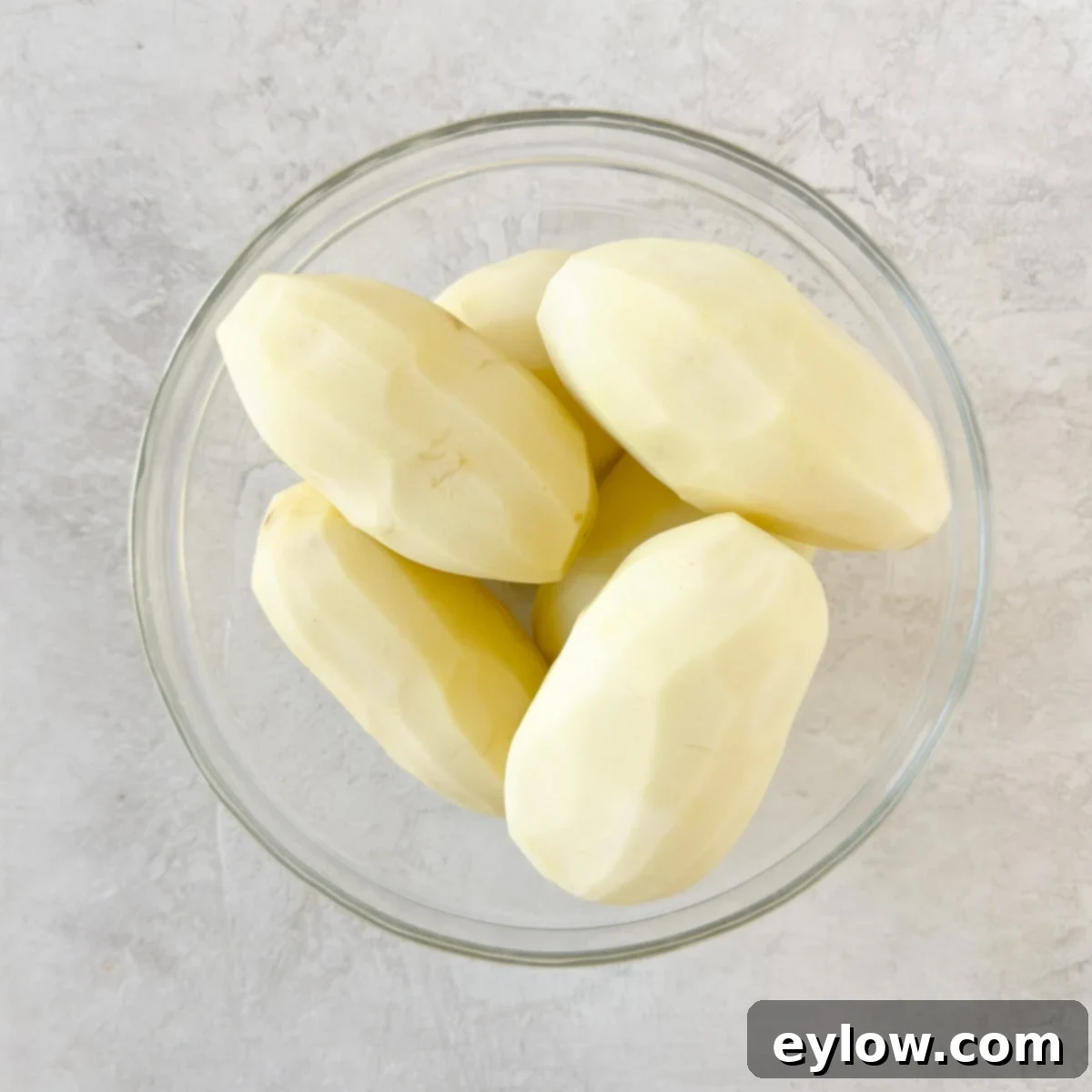
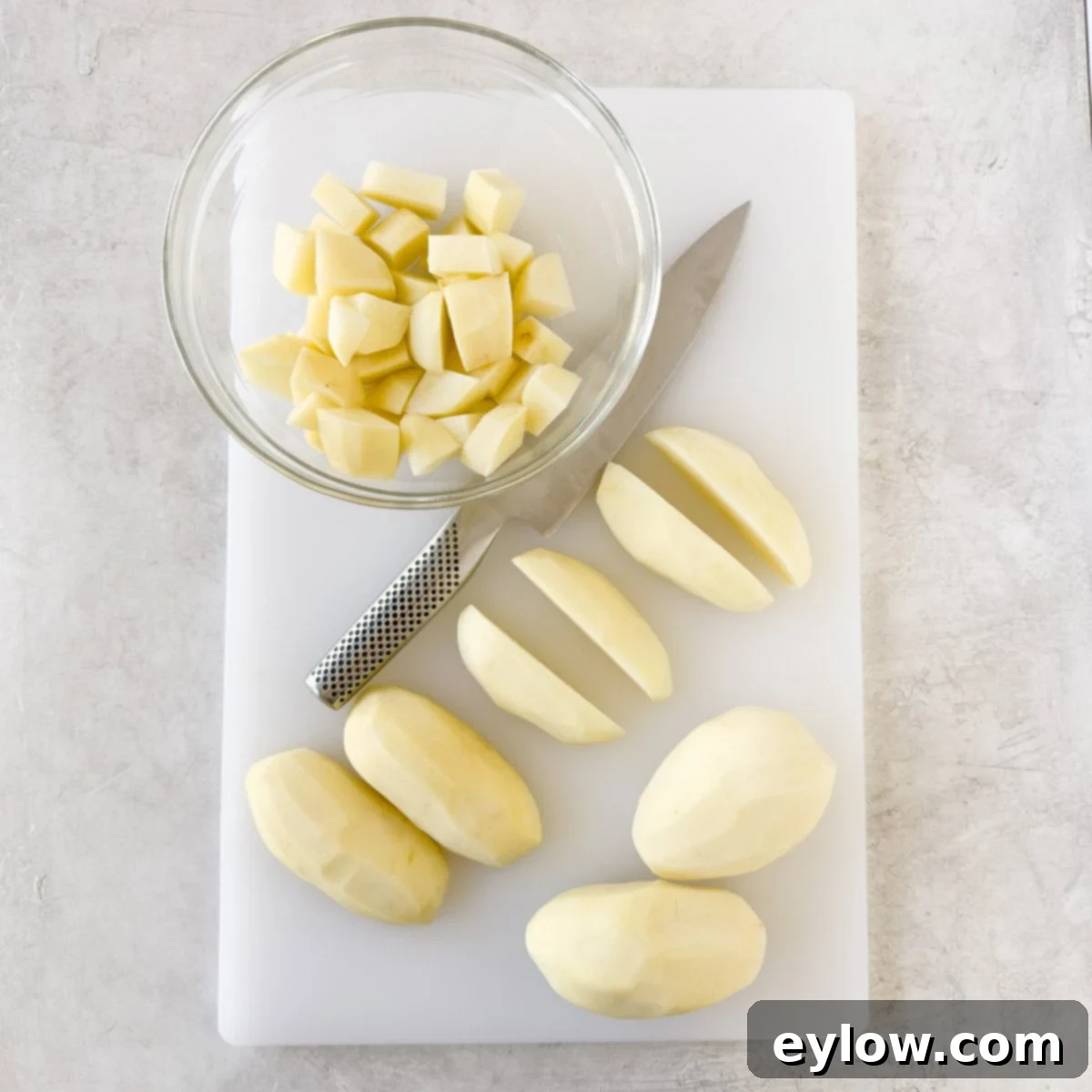
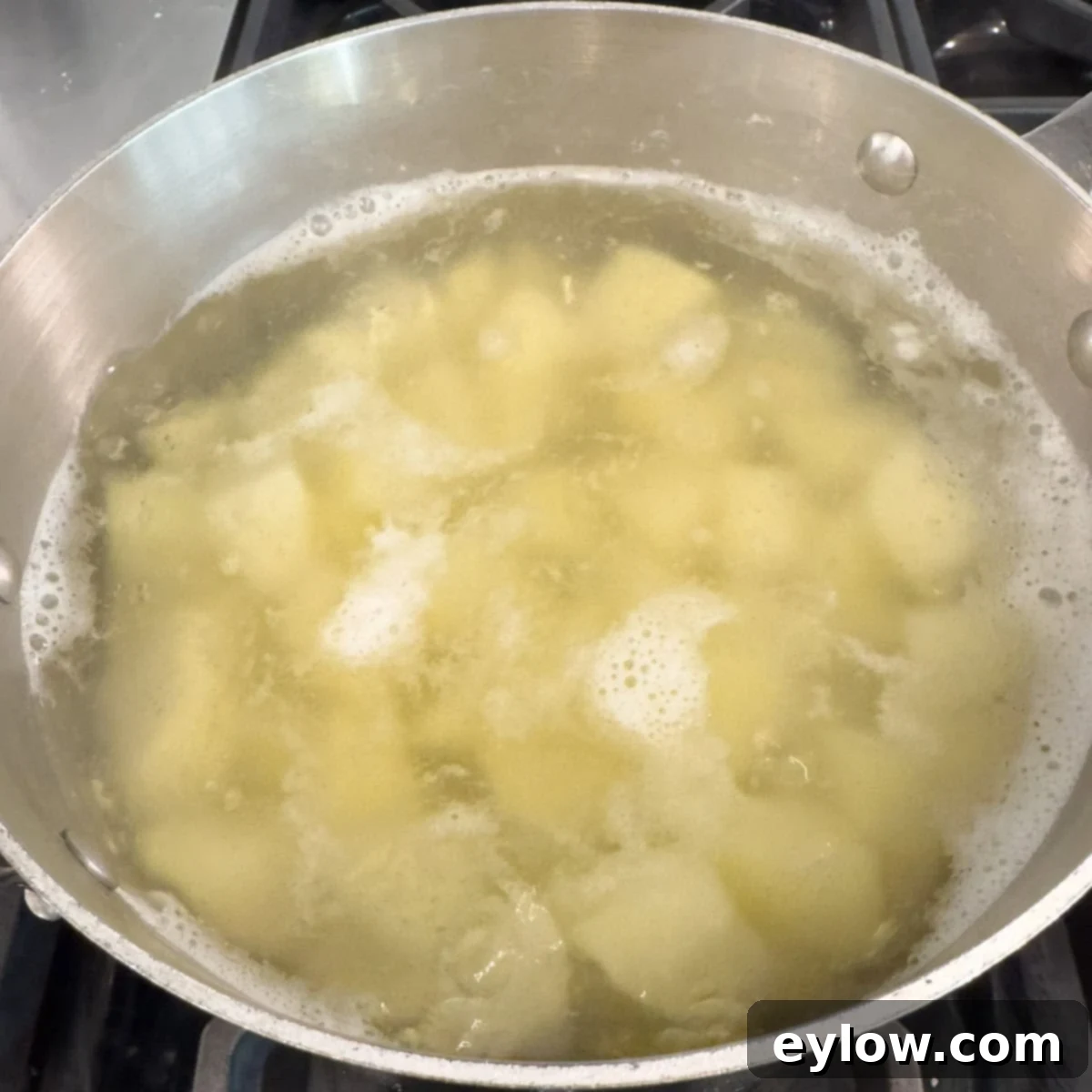
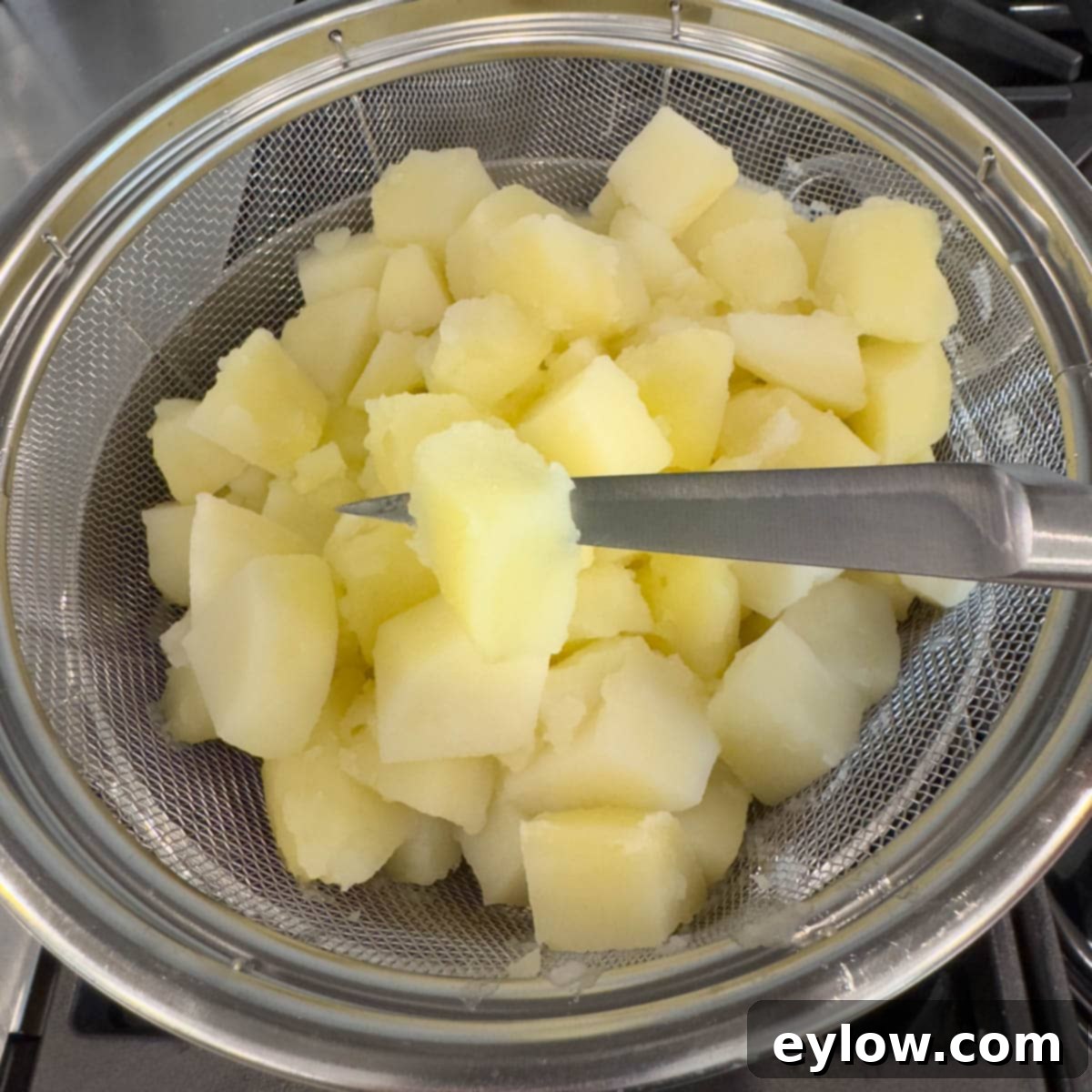


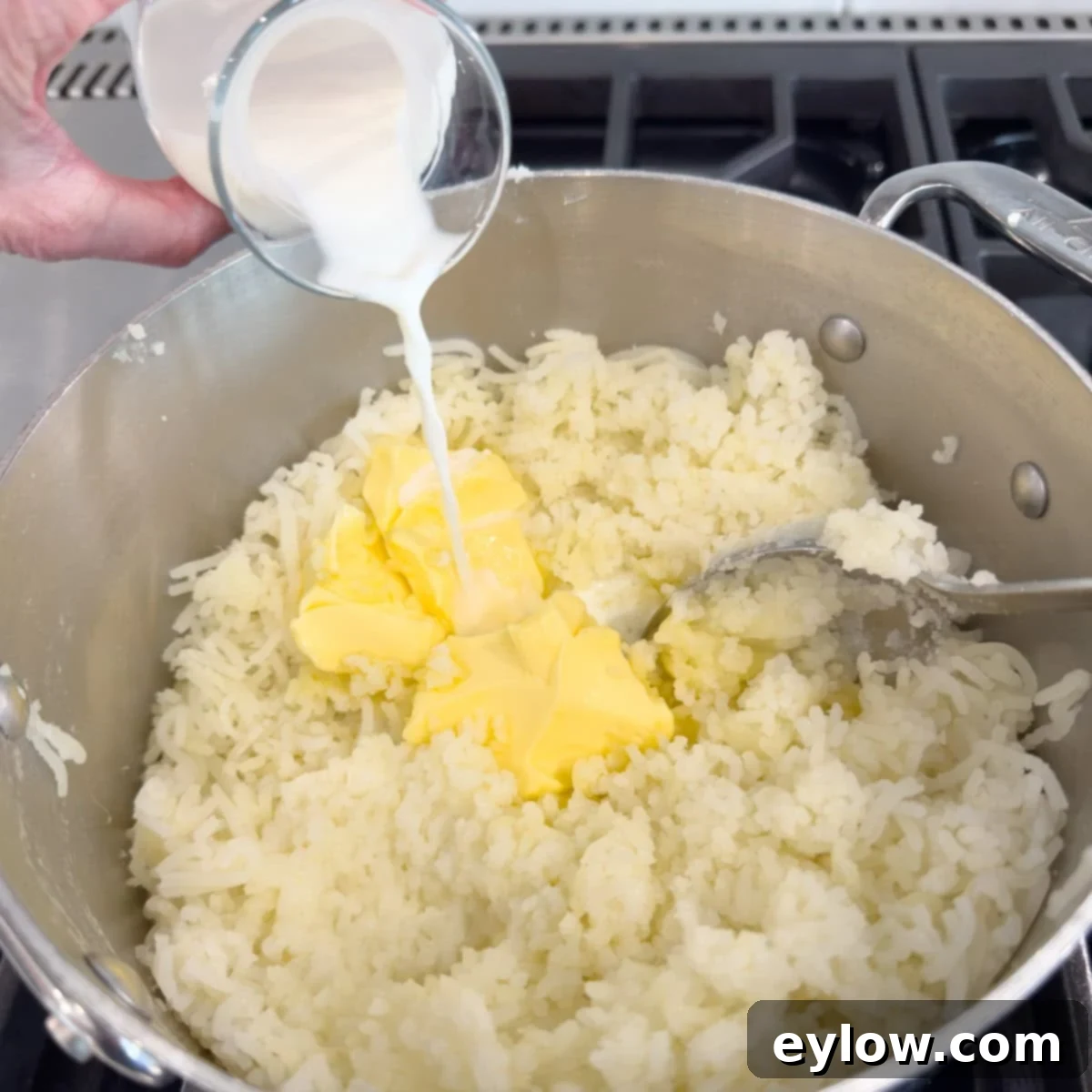
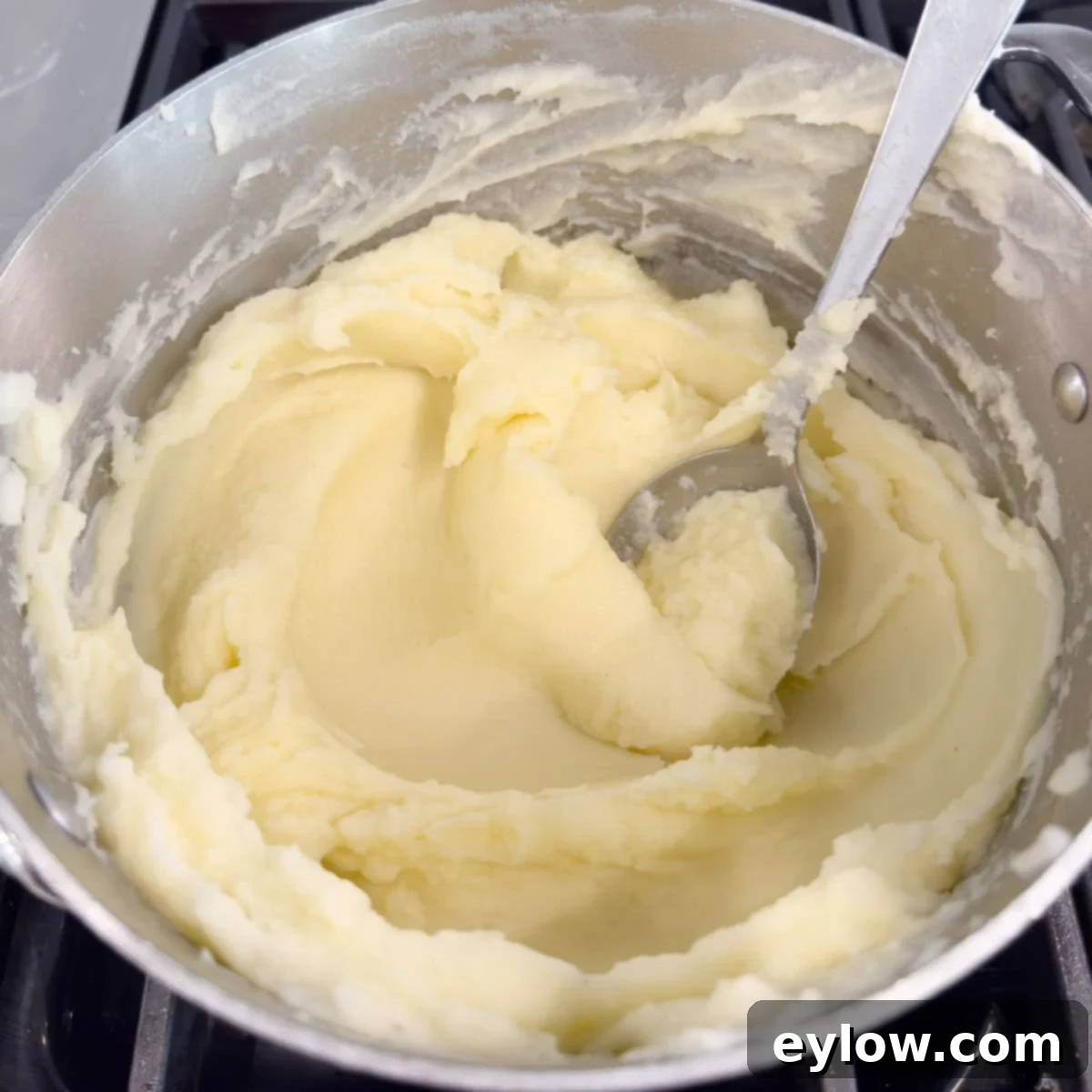
Chef’s tip on using a potato ricer for ultimate fluffiness: The key to truly fluffy riced mashed potatoes lies in precise cooking and careful moisture removal. First, ensure your potatoes are cooked until they are uniformly tender throughout, but critically, not falling apart or water-logged. Overcooked potatoes absorb too much water, making them mushy and difficult to dry effectively. After the potatoes are perfectly cooked and thoroughly drained through a colander, take an extra minute or two to “dry” them. Place the colander back on top of the warm, empty pot on the stovetop. The residual heat will help steam off any excess moisture, which is vital for preventing a dense or gluey result. Gently shake the colander a few times. Finally, when ricing, don’t overload the hopper; process the potatoes in batches to ensure smooth, even extrusion, and prevent the ricer from getting stuck or requiring excessive force.
Expert Tips for Peeling Potatoes Ahead of Time
Preparing ingredients in advance can be a huge time-saver, especially when cooking for a crowd or tackling a complex holiday meal. You can certainly peel your potatoes for riced mashed potatoes ahead of time, but proper storage is essential to maintain their quality and prevent both discoloration and bacterial growth. Here’s how to do it effectively:
- Submerge and Refrigerate: Once peeled, immediately place the potatoes in a large bowl or pot and completely submerge them in cold water. This prevents oxidation, which causes browning, and critically, slows down any potential bacterial growth. Store the covered bowl in the refrigerator.
- Change the Water if Needed: If you plan to soak the potatoes for more than a few hours, it’s a good practice to change the water. Fresh cold water helps prevent the potatoes from becoming slimy (due to starch release) or absorbing too much excess water, which could impact the final texture of your mashed potatoes. Change the water every 4-6 hours if soaking for an extended period.
- Avoid Over-Soaking: For the best texture and flavor, aim to soak peeled potatoes for no more than 8-12 hours. While convenient, prolonged soaking can lead to waterlogged potatoes, making them absorb less of your delicious butter and milk later on, and potentially contributing to a gluey texture.
- Thoroughly Drain and Dry Before Cooking: Before boiling, thoroughly drain the potatoes from the cold water. Then, it’s highly recommended to pat them dry with a clean kitchen towel or paper towels. This step is crucial because excess surface moisture can dilute your cooking water, making it less effective for salting, and can also contribute to a less fluffy end product.
By following these simple yet effective tips, your peeled potatoes will remain fresh, vibrant, and perfectly ready for making your famously creamy riced mashed potatoes whenever you’re ready to cook.
Delectable Serving Suggestions for Riced Mashed Potatoes
Perfect mashed potatoes are more than just a side dish; they’re a comforting culinary embrace that complements a wide array of main courses. Their creamy texture and rich flavor make them an ideal accompaniment for almost any meal. Here are some classic and creative serving suggestions for your fluffy riced mashed potatoes:
- Classic Roast Poultry: Pair with succulent roast bone-in chicken breasts, a whole roasted chicken, or a festive holiday turkey. The mashed potatoes beautifully soak up any pan juices.
- Elegant Duck: The richness of crispy seared duck breasts finds a perfect counterpart in the creamy, comforting texture of mashed potatoes.
- Flavorful Chicken Thighs: Serve alongside hearty Mediterranean chicken thighs, allowing the potatoes to meld with the savory juices and vegetables.
- Beef Roasts: A timeless pairing, roast beef tenderloin with a rich sauce is elevated by a generous dollop of mashed potatoes. They’re also excellent with pot roast or braised short ribs.
- Pork Perfection: Complement pork tenderloin with Dijon mustard sauce or a classic pork chop.
- Gravy & Sauce Magnet: Mashed potatoes are the perfect vehicle for soaking up savory gravies (like turkey or beef gravy), mushroom sauces, or even a simple herb-infused butter sauce.
- Creative Bases: Use them as a base for shepherd’s pie or cottage pie, creating a velvety topping that browns beautifully in the oven. They can also be piped around the edge of a plate for a restaurant-quality presentation.
For an extra touch of indulgence and visual appeal, consider drizzling additional melted butter and a sprinkle of fresh herbs (like chives or parsley) over the top just before serving. Any leftover riced mashed potatoes should be stored in an airtight container in the refrigerator for 3-4 days. While they can be frozen in a freezer-safe container for up to a month, note that the texture might be slightly less creamy upon thawing due to the separation of liquids. For best results, plan to enjoy them fresh or reheated from the fridge.
Mastering the Re-Heating of Riced Mashed Potatoes
One of the many advantages of riced mashed potatoes is that they can be prepared ahead of time, making meal planning and entertaining significantly easier. If you’ve made a batch in advance and refrigerated them, here are four excellent methods to reheat them, ensuring they retain their creamy, fluffy texture. Remember, the colder the potatoes, the longer they will take to heat through. For optimal results, remove them from the refrigerator about an hour before reheating to take the chill off. Reheating times will vary based on the quantity of mashed potatoes.
- Stovetop Method (Best for Creaminess): This is arguably the best method for maintaining a creamy texture. Place the mashed potatoes in a large pot or saucepan over low to medium-low heat. Add a splash of milk (or cream/broth) – about 1-2 tablespoons per cup of potatoes – and stir frequently with a wooden spoon or spatula. Partially cover the pot to help retain moisture. Continue to stir occasionally until they are heated through and smooth. You may need to add a bit more milk or a pat of butter as they warm up to restore their original creamy consistency. Gentle heat and constant attention prevent sticking and burning.
- Oven Method (Great for Larger Batches): Transfer the mashed potatoes to an oven-safe dish. To prevent them from drying out, stir in a little extra milk or butter, then cover the dish tightly with aluminum foil. Bake in a pre-heated 350°F (175°C) oven for about 20-30 minutes, or until thoroughly warmed through. For even heating, stir the potatoes halfway through the baking time. If they seem a bit dry, add a tablespoon or two of warm milk or butter and gently stir. Always ensure potatoes reach an internal temperature of 165°F (74°C) using a digital thermometer for food safety.
- Slow Cooker Method (Ideal for Keeping Warm): This technique is my go-to for catered parties, as it keeps mashed potatoes warm and moist for hours without drying. Place the mashed potatoes in a slow cooker and set it to the “low” setting. Stir every 20-30 minutes, adding a splash of milk or broth as needed to maintain their creamy texture. A brilliant trick to prevent condensation from dripping onto the potatoes is to place a clean kitchen towel between the lid and the top of the slow cooker; it absorbs the moisture, leaving your potatoes perfectly fluffy.
- Microwave Method (Quick and Convenient): For smaller portions or quick reheating, the microwave is a good option. Place the mashed potatoes in a microwave-safe dish. To prevent drying, cover the dish with a lid or a damp paper towel. Reheat in 1-minute increments, stirring thoroughly between each interval, until the potatoes are fully warmed through. If the texture needs refreshing, stir in a small amount of butter or warm milk. Be careful not to overheat, which can make them dry.
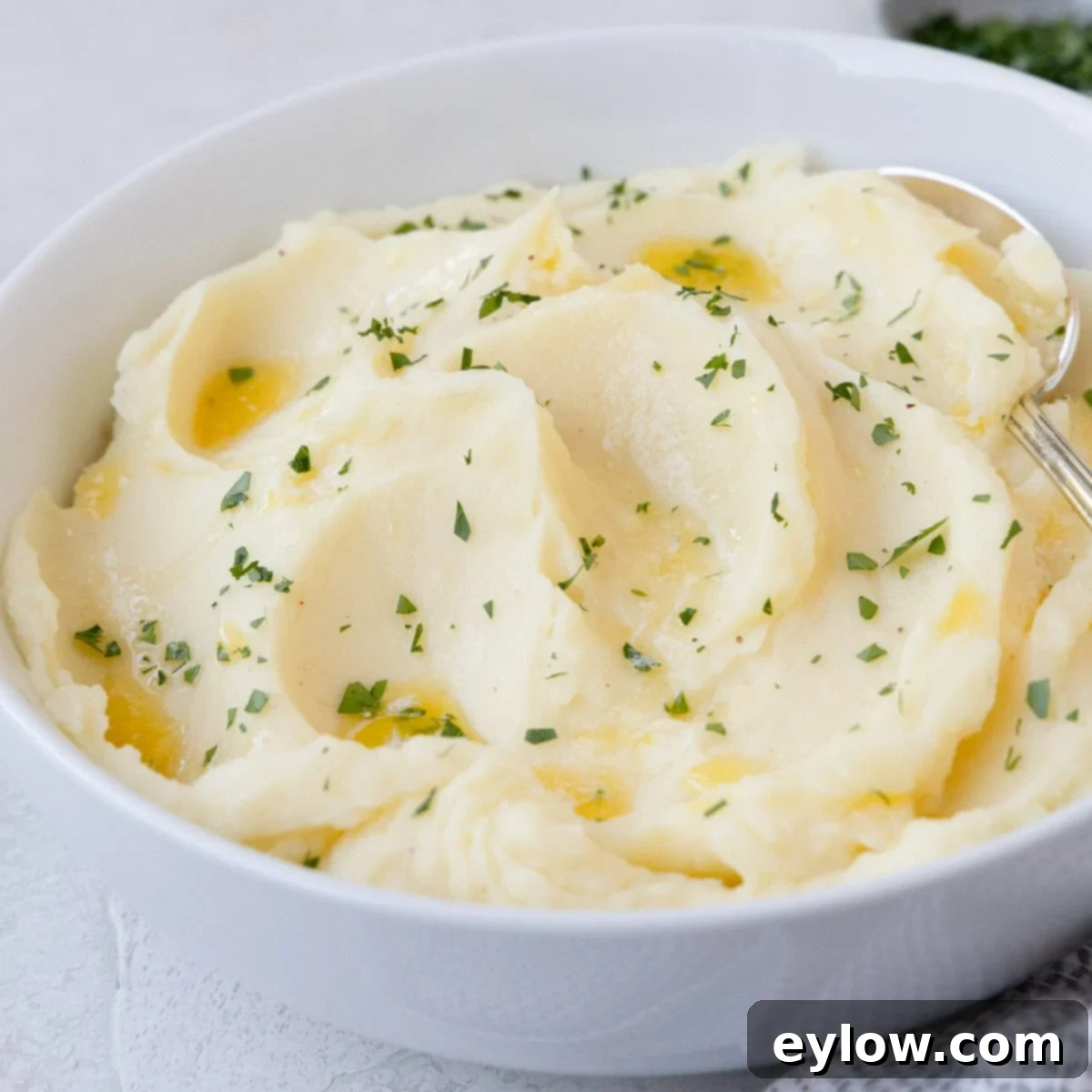
Recipe FAQs for Riced Mashed Potatoes
Russet potatoes are undoubtedly the top choice for creating the fluffiest and creamiest riced mashed potatoes due to their high starch content. Their dry, floury texture breaks down easily when riced, preventing gumminess. While you can use gold potatoes (like Yukon Golds) if you prefer, be aware that their lower starch and waxier texture will result in a denser, moister, and more velvety mash, rather than the light and airy fluffiness achieved with russets.
Yes, for smooth and consistently creamy riced mashed potatoes, it is highly recommended to peel the potatoes before cooking and ricing. Leaving the skins on would result in a textured mash with small bits of skin, which detracts from the desired velvety consistency. Peeling also makes the ricing process much easier and more efficient.
Absolutely! Riced mashed potatoes are an excellent canvas for various flavor additions. Popular options include roasted garlic, which offers a mellow, sweet depth, and finely grated Parmesan cheese for a savory, umami boost. You can also experiment with fresh herbs like chives, rosemary, or thyme, or even a dash of nutmeg for warmth. The best approach is to start with a small amount of your chosen flavor, mix it in gently, and taste as you go. This allows you to achieve the perfect balance without overpowering the delicate potato flavor or altering the texture too much.
The ideal amount of butter and liquid for riced mashed potatoes is a matter of personal preference, but a good starting point is about 4 ounces of warm milk (or half and half) and 3-4 tablespoons of softened unsalted butter per pound of potatoes. The golden rule is to always start with less and gradually add more while gently stirring and tasting. This iterative approach ensures you achieve your desired level of richness and creaminess without making the potatoes too thin or overly buttery. While heavy cream is an option, I often prefer whole milk or half-and-half as they provide ample richness without making the mashed potatoes feel too heavy or overly decadent for a side dish.
Preventing gluey mashed potatoes is one of the main reasons to use a potato ricer! Gluey potatoes occur when the starch cells are over-processed or ruptured, releasing too much starch, which then becomes sticky. To avoid this, always use a potato ricer (or a food mill) instead of an electric mixer, food processor, or even vigorously mashing with a hand masher. Also, ensure your potatoes are cooked just until tender—not overcooked—and drain them thoroughly, even drying them slightly on the stovetop heat as suggested in our instructions. Finally, once riced, mix in your warm butter and milk gently and sparingly, just until combined, to avoid overworking the potatoes.
While a potato ricer is the gold standard for achieving the fluffiest, creamiest texture, you can still make mashed potatoes without one. A sturdy hand masher will work, though you may end up with a slightly lumpier texture. For a smoother result without a ricer, a food mill is an excellent alternative. Avoid using a blender or food processor, as these appliances overwork the starch and are almost guaranteed to give you gummy, gluey mashed potatoes. Whichever method you choose, ensure the potatoes are well-cooked and drained, and add your liquids and butter gently.
More Irresistible Potato Recipes to Try
If you’re anything like me, you have a deep appreciation for the humble yet versatile potato! Beyond the magic of riced mashed potatoes, there are countless delicious ways to enjoy this beloved vegetable. From sweet and savory mashes to crispy roasted delights, here are more fantastic potato recipes to inspire your culinary adventures:
- Simple Whipped Sweet Potatoes Recipe
- Air Fryer Red Potatoes (or oven roasted)
- Crispy Baked Garlic and Parmesan Potatoes
- Cheesy Au Gratin Potatoes
⭐️ Did You Make This Recipe?
If you’ve whipped up a batch of these glorious riced mashed potatoes, I would absolutely love to hear from you! Your feedback is invaluable, and I truly enjoy hearing about your cooking experiences. Please take a moment to add your comment below and share how it turned out. If you loved them as much as I do, please consider giving it a 5-star rating! Your ratings and reviews are incredibly helpful to other readers looking for delicious and reliable recipes.
📖 Recipe
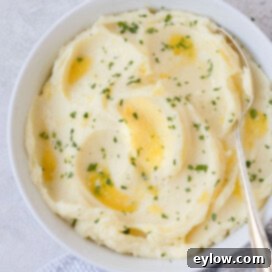
The Fluffiest Riced Mashed Potatoes
Sally Cameron
Pin Recipe
Equipment
-
Potato Ricer (essential for the ultimate fluffy texture!)
-
Large Pot (for boiling potatoes)
Ingredients
- 3 pounds russet potatoes (about 6 medium-sized, for that perfect fluffy texture)
- 6 ounces warm milk (whole milk, low-fat, half-and-half, or your favorite non-dairy alternative)
- 6 tablespoons unsalted butter (softened or melted, for richness and flavor)
- 1 tablespoon sea salt (for salting the cooking water, seasoning from within)
- ½ teaspoon sea salt (or more, to taste)
- ¼ teaspoon white pepper (optional, for a clean look without black specks)
- Fresh chives or parsley (chopped, for garnish, optional)
Instructions
-
Begin by thoroughly peeling your russet potatoes. Once peeled, chop them into roughly 1-inch (2.5 cm) uniform pieces. Ensuring the pieces are of similar size is crucial for even cooking, which prevents some potatoes from becoming waterlogged while others remain undercooked.
-
Place the chopped potatoes into a large pot and cover them with cold water, extending about 1 inch above the potatoes. Add 1 tablespoon of sea salt to the water; this seasons the potatoes from the inside as they cook. Bring the water to a gentle simmer over medium heat, then reduce the heat to maintain the simmer. Cook for 10-15 minutes, or until the potatoes are tender when easily pierced with a paring knife. While potatoes are cooking, gently warm your milk in a small saucepan and ensure your butter is at room temperature or slightly melted. This prevents the cold additions from chilling your hot mashed potatoes.
-
Once cooked, immediately drain the potatoes thoroughly through a colander. For extra fluffy results, place the colander back on top of the warm, empty pot for a minute or two to allow any excess moisture to steam off. Now, place your potato ricer over the same warm pot or a large mixing bowl. Spoon the hot potatoes into the hopper of the ricer (working in batches if necessary) and press them through into the pot.
Once all potatoes are riced, add the softened butter and warmed milk gradually. Using a large spoon or spatula, gently fold the ingredients into the riced potatoes until they are just combined and reach your desired creamy consistency. Be careful not to overmix, as this can still lead to a gluey texture. Season with the remaining sea salt and a little white pepper (if using) to taste.
Serve your perfectly fluffy riced mashed potatoes immediately. Leftovers can be stored in an airtight container in the refrigerator for 4-5 days. For make-ahead purposes, they can be frozen for up to a month, though the texture might be slightly less creamy upon thawing. Refer to our “Four Ways to Re-heat” section above for detailed reheating instructions.
Notes
For no-dairy or vegan riced mashed potatoes: Simply substitute dairy milk with unsweetened coconut milk, almond milk, oat milk, or any other preferred plant-based milk. For butter, use a high-quality plant-based butter alternative to maintain richness and flavor.
Flavor Enhancements: Feel free to customize your mashed potatoes! You can add roasted garlic (squeeze softened cloves into the riced potatoes), finely grated Parmesan cheese, fresh herbs like chives or rosemary, or even a hint of nutmeg for a subtle warming spice. Always add these to taste, stirring gently.
For comprehensive instructions on four different ways to re-heat riced mashed potatoes after refrigerating (if you’re making them ahead of time), please refer to the dedicated section in the main post. We cover stovetop, oven, microwave, and slow-cooker methods to ensure your leftovers are just as delicious as the fresh batch.
